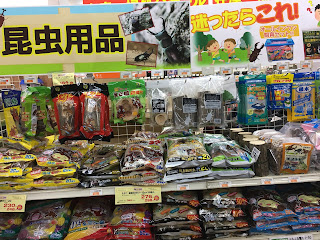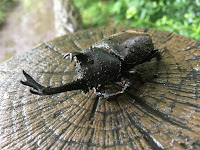 |
| Shop displaying various goods for taking care of beetles |
The noisiest insect in Japan in the summer must be the
cicada, but the most sought-after are the different varieties of beetle. In the evenings, you will often see young children accompanied by parents carrying a net, insect box (
mushi-kago/kēsu), and a flashlight (these insects are nocturnal) searching trees for the prized beetles. One trick is to smear sugar-water (
satō-mizu =砂糖水) onto the tree trunks to attract the prized-pets. Once captured, they are looked after carefully and a source of pride to many children; stores sell a whole gamut of insect goods (
konchū yōhin =昆虫用品) from food (jelly) to logs and fly sheets (pictured right). Famous Japanese actor Aikawa Sho (哀川翔) is well-known for his love of beetles and sells a "breeding set" (
shi-iku setto =飼育セット) including maggots (
yōchū =幼虫) for ¥1,420
here! The maggots, incidentally, can be found for free if one is prepared to engage in a bit of digging in the soil at the base of the trees...
 |
| Stag Beetle (kuwagata-mushi) |
 |
| Rhino Beetle (kabuto-mushi) |
In terms of beetle types, the most well known are the stag beetle (kuwagata-mushi), with pincers or "antlers" (pictured left) and the most highly prized rhinoceros beetle (kabuto-mushi) with its distinctive long and short horn (pictured right): the word
kabuto means samurai helmet in Japanese. As the flyer below shows there are a number of variations based around these two main types. For children who capture and keep these as pets during the summer months, a popular pastime with friends is
beetle fighting: typically two beetles are placed on a log and the loser is the one who gets shoved off. This is even enjoyed by adults, especially in Okinawa, where it has become a somewhat problematic form of gambling.
 |
| Newspaper flyer for a summer housing fair advertising a Natsu no Ikimono (Summer Animal) exhibition (original here) |







